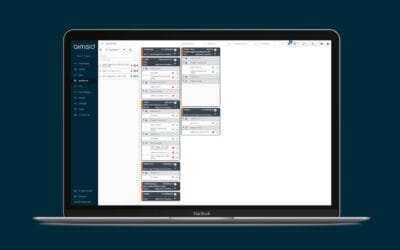Congratulations on deciding to start using Aimsio. We think it’s a smart choice (but we would think that, wouldn’t we!). Whether you’ve just signed up or are almost ready to roll it out to your entire team, this article will provide you with some helpful tips so that you and your organization are set up for success. These are our best practices for rolling out Aimsio.
First off, we want to acknowledge the effort that it’s taken to get this far. You’ve done the research, sat through numerous demos, and made sure that you have buy-in across your organization. These are no small tasks. And there will be more tasks ahead of you to roll out Aimsio, but we will be with you 100% of the way. We won’t leave you hanging.
The best practices we list out below are exactly those – best practices. We have had lots of clients choose not to do these things (or do variations of these things instead), and those roll outs have also been successful. However, in our experience, if you choose to do any or all of these things, you have the best shot of a successful roll out.
One of the things that is important to keep in mind while reading this article is that you get to choose where you want to do the work. If you choose to do these best practices, you’ll get the work done right off the bat – getting ahead of the questions. If you choose to ignore some of these best practices you may find yourself needing to rectify the situation after the fact by providing extra training. But however you choose to roll out Aimsio, we’ll be there to guide you. You are not doing this alone. Our specialized team knows how to onboard customers – and they love doing it. But don’t take our word for it, here’s what one of our customers had to say about the Aimsio team:
“Aimsio has an amazing product and their team is something that other businesses dream of having. If your business is looking to go to the next level or strategically set itself apart from the crowd, you need to check Aimsio out.”
– Jeff M., Project Controls, MAXX North America Services Ltd. and Total Evolution Consulting Inc.
Okay, now that’s out of the way, let’s dive right into the best practices for rolling out Aimsio.
1. Write and Send a Campaign Roll Out Letter
A campaign roll out letter is a powerful tool in your Aimsio roll out. A campaign roll out letter usually includes things like:
- What Aimsio is used for
- How each department will use Aimsio
- Why you have decided to start using Aimsio
- The benefits of using Aimsio
- A rough timeline of the roll out
- An internal contact person who people can reach out to with questions
If you are still uncertain about what to include in your campaign roll out letter, ask your onboarding team for a sample letter or for some ideas.
We suggest sending your campaign roll out letter to all internal departments who will be using Aimsio. This helps to prepare everyone and get them on the same page. The last thing you want is for Aimsio to be a surprise to anyone. We’re all creatures of habit and surprises can turn even the best of us into sassy, angry monsters when we feel like we’re being told to switch our habits at the drop of a hat. The more time you can give your organization to come around to the idea that Aimsio is on the horizon, the better. In fact, if you find that you are already receiving some questions about why Aimsio is necessary, this article explains how to combat common onboarding hurdles such as:
- “Going paperless might screw everything up.”
- “The old way is faster.”
- “I don’t want to learn a new technology”
- “Everyone’s too busy for this right now.”
- “We can’t risk losing any info.”
In addition to sending a campaign roll out letter to your internal team, some of our clients also choose to send one to their external customers. In this letter, the goal is to explain to them that you will be switching platforms and that this is a planned investment. This is more of an FYI situation as typically our clients’ customers are happy to see that their vendors are going digital as it makes their life easier.
2. Write and Send an Internal Process Document
With every roll out of Aimsio, we always provide user guides. We’re not going to set you up with a brand new system and not give you the keys to understanding it. That would be like sending you home with a new car and not telling you how to turn it on. However, keep in mind that your Aimsio system has been set up specifically for you. So while the user guide will do a fantastic job of telling you how to use Aimsio, it may not use terminology or processes specific to your exact workflows.
We’ll walk you through how to use your specific Aimsio account. And after that, we recommend you put together an internal process document on how each department will use Aimsio. You know your organization the best, so you know exactly how your work will flow through each department.
We also recommend splitting out this document by roles. For example, a user guide for field workers, a user guide for the accounting team, etc. In each document, start with the user guide we provide for you and then add your specific details for each department. This ensures that the data is collected and reported on in a way that is actually helpful for you. And as usual, if you have any questions along the way, just reach out to your onboarding team.
3. Start Small and Recruit Champions and Advocates
Before you get the keys to your brand new Aimsio account (aka the Production account), you will first be given the keys to something we call a Sandbox account.
Sandbox Account: An exact replica of your Aimsio Production account, but instead of using all of your real data, it’s a place for you and your team to play around (hence sandbox) and get to know Aimsio. Your Sandbox account is there for you to get your hands dirty and make mistakes. In fact, if you make a mistake in your Sandbox account, it is easy for us to fix it. Do all of your testing and training in your Sandbox account.
Production Account: Your final Aimsio account where you capture and store all of your real data. Fewer people at Aimsio have access to this account so if you do make a mistake, it often takes longer for us to rectify it.
The goal is for your entire team to use the Production account. But if you skip the Sandbox step, you’ll find you’re met with confusion and mistakes. So what’s the best approach here?
We recommend you do all of your testing and training in your Sandbox account. Then, identify one crew or group who truly has a good understanding of Aimsio. Once you’ve figured out who this group is, move them to the Production account. Now you have a small group of people using the Aimsio Production account for one job or project from start to finish. Empower them to ask questions so that they fully understand the software. Now you have a group of people who are champions in the field, supporting your roll out. When it’s time to roll out the Production account to the entire company, you’ll have the support of the field crew behind you.
While this may seem slower than, say, requiring the entire company to switch to the Production account at the same time, you will actually find this way is quicker and user adoption will be higher. This comes back to the choice: do you want to do the work upfront or on the backend? If you have a team of champions with you, they will help spread knowledge and empowerment to the team, making the roll out smoother and quicker. We want to get your entire team to Production as soon as possible, and we have found that this is a fantastic way to get team buy-in and ensure everyone is comfortable with Aimsio.
So there you have it. Those are our best practices for rolling out Aimsio. We hope you find them helpful and if you have any questions, our onboarding team is always here to help you.




